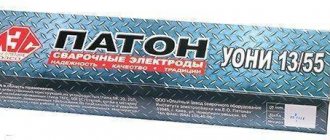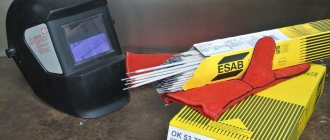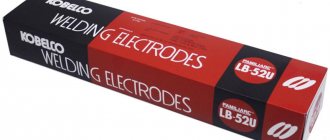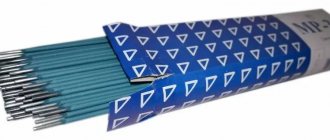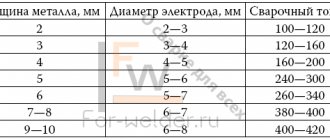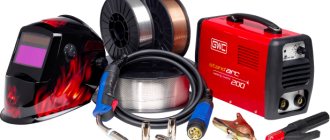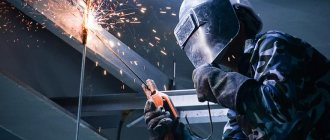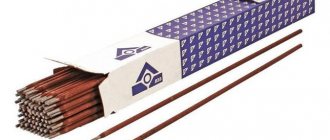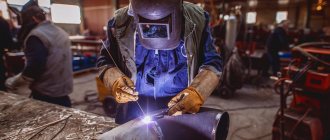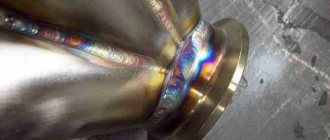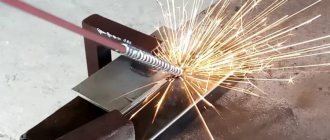An electrode for manual arc welding can be thought of as a piece of special wire coated with a special substance - coating. The rod and coating perform different jobs during welding: the wire connects the metal, and the coating improves the weld and maintains the arc. The final quality of work depends on the competent choice of both of these components. The main part of the welding electrode is its coating. In this article we will look at the types of electrode coatings for welding.
Welding wire comes in different thicknesses (from 1 to 12 mm), its diameter is considered the diameter of the electrode. Most often, rods with a thickness of 3 - 6 mm are used, as they are suitable for most typical technical tasks. But the choice of coating is not so simple: it depends both on the specifics of the work and on the qualities that the welder wants to endow with the resulting seam. That is why it is worth understanding the functions and types of coating better.
What is this method
Electrodes for electric arc welding have a great influence on the release of a sufficient amount of heat necessary to melt the metal of the welded products, so their correct selection and proper use play a big role.
An electrode is a metal rod coated on the outside with a coating that is a special composition. During the welding process, the electrode core begins to melt. The metals of the rod and the product, being in a molten state, together form a joint. When burned, the coating releases a gas necessary to protect the welding zone from the negative influence of surrounding oxygen and nitrogen. Electrodes for arc welding solve a number of important problems.
The substances included in the coating have a low ionization potential. The consequence of this is that the arc, after its ignition, is saturated with ions that are in a free state. This stabilizes the arc burning process.
The coating takes part in the formation of slag on top of the weld, which reduces the rate at which the molten metal cools. This creates good conditions for removing impurities and non-metallic inclusions from the seam, which impair the quality of the joint.
Electrode coatings contain deoxidizers whose job is to react with oxygen, causing it to bind. With the help of electrodes, the metal forming the weld is alloyed, which improves its properties. This is ensured by substances included in the coating, such as silicon, chromium, manganese, and titanium.
Storage
Storing electrodes is a topic that for some reason many people avoid. And in vain. After all, a beginner can follow the welding technology and generally weld correctly, but the weld will be of poor quality due to the fact that the storage conditions have been violated. And the welder, due to his inexperience, will blame everything on a bad welding machine, inconvenient working conditions, or any other reasons.
Yes, if stored incorrectly, electrodes can indeed significantly deteriorate the quality of the finished welded joint. And all because of the moisture that the electrodes actively absorb. For this reason, it is not recommended to store electrodes in damp, stuffy areas, such as basements. Also, do not store electrodes on the ground, even if they are in a box. And don't use storage boxes at all. Replace them with a special case. You don’t have to buy it; you can make it yourself from a section of HDPE pipe.
After all, the box is just a package of electrodes; it is not intended for long-term storage in a garage or on mezzanines. Try to ensure that there are no strong temperature changes in the room. This is obvious, but many people leave electrodes in an unheated garage all winter and then wonder why the rods crumble or why the arc doesn't strike.
Separation by coverage
The classification of electrodes for manual arc welding allows them to be differentiated according to many characteristics. One of the most common is what kind of coating these consumables have. The coating of electrodes for manual arc welding is often decisive when it is necessary to decide on their purchase.
Types of electrode coatings for manual arc welding have divisions:
- Rutile . This element is titanium dioxide. With this type of coating, metal spattering is reduced, fluidity increases, and a thick layer of slag is formed, which can then be easily separated. However, the risk of formation of defects such as pores is high. It is advisable to use it for connecting parts of small thickness made of low-carbon steel.
- Pulp . In addition to the cellulose itself, the coating contains silicon and magnesium. This coating increases gas formation, which reliably protects the weld pool. The spatterability of the metal is increased. It is convenient to weld vertical seams, but one cannot expect an aesthetic appearance.
- Basics . The main elements are derivatives of calcium and magnesium. This provides high mechanical strength. The weld metal is chemically pure. The big advantage is the ability to weld in any position. Can be used for welding critical structures.
- Sour . They are used only for making horizontal seams. There is a risk of cracks and undercuts. May pose a health hazard to the welder.
Each type has its own designation. Rutile coating is designated by the letter “R”, cellulose by the letter “C”. If the coating is a mixed type of rutile and cellulose, then two letters “RC” are used.
The base coating has the letter “B”, which means base. Acid coating is assigned the letter "A". The letter “P” denotes other coatings. The letter “C” means that we are talking about a special coating, with which it becomes possible to carry out the process under water.
Common models or which electrode is better to choose
Today there are a huge number of different electrodes produced by different manufacturers. Beginners are often confused by such a wide variety, so below are the characteristics of popular brands of rods:
- MP-3C are universal consumable models designed to work with constant and variable frequency current. The advantage of the products is the easy ignition of the arc not only during the first, but also subsequent ignition. Rutile is used as a coating, which effectively protects the joint from oxidation and slag penetration.
- ANO-37 - products are designed to work with low-carbon steels. They are distinguished by their unpretentiousness in working with metals that have rust. They are also easy to light, which is great for beginners.
- OZS-4 is another type of electrodes that are easy to use. Their main feature is that they can cook metal not only with contaminants and rust present, but also with moisture.
- UONII-13/55 is another popular type of consumables. They serve not only for welding thin metal, but also for connecting critical structures operated at subzero temperatures. Before work, it is recommended to remove dirt and rust from the metal.
Electrodes are supplied in cardboard or plastic packages, which contain detailed instructions for their use. It must be studied before use, because the quality of welding operations depends on it.
Thickness
Types of electrodes for manual arc welding are divided according to the thickness of the coating, which depends on the diameter of the internal rod. However, the division is carried out not on the exact dimensions, but on the relationship between them.
Thin coating is designated by the letter "M". The thickness of the coating is 20 percent of the diameter of the rod. Medium coverage is designated by the letter “C”. This is the most common option. The thickness of the coating is 45 percent of the diameter of the rod.
Thick coating is designated by the letter “D”. The thickness of the coating is 80 percent of the diameter of the rod. Over 80 percent has a particularly thick coating, designated by the letter “G.” The correct choice of cross-sectional size is also important. It depends on the thickness of the prepared edges of the products being joined.
Marking of electrodes and determination of the type of coating
Due to the wide variety of types of electrodes, of which there are more than 200 in total, universal marking was introduced. It is an alphanumeric designation by which the technical parameters of products can be determined. There are two types of markings - Russian and foreign, so we will consider both variants of designations, and learn how to independently determine the type of coating and other important parameters. For the convenience of considering the markings, let’s take the following example, as shown in the photo.
The following information is obtained from the alphanumeric designation:
- E - indicates belonging to the electrodes.
- 46 - numbers that indicate the value of the tensile strength of the rupture. It is measured in kg/mm2 and affects the strength of the seam. The higher the value, the correspondingly stronger the connection will be.
- ANO-21 - brand.
- 2 - diameter.
- UD - the letter “U” designates the type of metals for which the electrodes are intended for welding. In this particular case, the letter “U” denotes the type - carbon steel. The letter “L” is for alloyed steel, “B” is for high-alloy steel, “T” is for heat-resistant steel, and “H” is for steel with special properties. The letter “D” is the thickness of the coating or coating; in a particular case, it indicates a large value with a coefficient of 1.45-1.8.
- E430/3/ - mechanical load index.
- P - type of coating. In a specific case, the rutile layer is indicated.
- 11 - numbers that indicate the position of the electrode during welding and its polarity. Values in the form of one indicate that this is a universal rod type that can be used in any position and with different polarities. In total, there are four types of positions: 1 - any, 2 - everything except the vertical position from top to bottom, 3 - horizontal welding from below and vertical from bottom to top, 4 - bottom seam in the horizontal direction.
To indicate the thickness of the coating, the corresponding letters with a coefficient limit are used:
- G - the thickest coating over 1.8;
- D - thick (from 1.45 to 1.8);
- C - average (1.2 - 1.45);
- M - thin up to 1.2.
The following numbers are used to indicate the polarity of products:
- 0 - for direct current with reverse polarity;
- 1-9 - any type of current;
- 1, 4, 7 - any type of polarity;
- 2, 5, 8 - straight polarity;
- 3, 6, 9 - reverse polarity.
To secure the material, we will consider another option for marking Russian-made electrodes. Below is a photo with markings.
This is interesting! One fact worth noting is that the packaging indicates the GOST number according to which the products are manufactured. Based on this number, it will not be difficult to find a more in-depth explanation of the technical parameters on the Internet.
- E50A is a product with a high tensile strength. The letter “A” indicates the improved properties of the resulting seam.
- UONI-13/55 - brand.
- UD - products are intended for welding carbon and low-alloy structural steels.
- E514 - index.
- B - type of coating. The letter "B" represents the base layer.
- 20 - the first digit indicates the type of spatial position for welding. If the number “1” indicates any type of spatial position, then “2” indicates the ability to work in any position, with the exception of vertical seams from top to bottom. “0” - indicates the ability to cook with electrodes with reverse polarity.
Knowing what is encrypted in the markings, it will not be difficult to choose welding consumables. Very often, novice welders turn to sellers for help in the hope that they will select the right consumables. In the end, everything turns out the other way around, and therefore now you can check the competence and knowledge of the sellers, as well as choose the most suitable electrode to make a high-quality connection.
Next, we will look at foreign markings of rods. It looks like this, as shown in the photo.
Attention should be paid to the letters RC, as well as the numbers 11. These letters indicate the type of coating:
- R - rutile;
- C—cellulose;
- B - main;
- A - sour.
With numbers, it is important to remember one feature - the type of spatial position and polarity differs from Russian markings. The first number indicates the polarity, and the second - the position of the electrode.
Professional welders rarely use markings, since it is enough to look at them to determine the type of coating. If you bought not a package of electrodes on the market, but a certain quantity, then you can also determine the type of coating yourself. To do this you need to perform a visual inspection:
- The rutile electrode has a rough and heterogeneous surface.
- The base coating is characterized by uniformity of the layer and smoothness to the touch.
To check, you can also use an additional method, which involves deforming the rod. If you bend it, the rutile layer will hold on, but on the main one it will begin to crumble depending on the degree of deformation. In the video material you can learn about what types of electrodes are best for cooking at home.
Purpose
The letter “U” in the marking of electrodes means that they are applicable to carbon steels, including low-alloy steels. The letter “L” means that the electrodes are intended for connecting products made of alloy steels, which have increased strength.
For structural high-alloy steels, electrodes with the letter “B” are applicable. For heat-resistant alloy steels, electrodes with the designation “T” are used. For alloys with special properties, in particular for surfacing, consumable elements designated “H” are used.
How to choose an electrode for an inverter
When selecting suitable electrodes, one should take into account the performance characteristics of the equipment and the features of the assortment from which the welded structure will be assembled. A novice master can use reference books or get advice from experienced colleagues. The performance of welding work, the quality and durability of the seams depend on the correct choice.
By purpose
At the initial stage, you should clarify the characteristics of the inverter, which can be equipped with a rectifier to produce constant voltage. There are combined type electrodes designed for both alternating and direct current. Manufacturers indicate the permissible connection polarity; there are requirements for the minimum open circuit voltage.
You should also take into account the compliance of the inverter in terms of output power. If the characteristics are insufficient, the arc will not light up or will be weak or intermittent.
By coating material
Products with a basic coating make it possible to obtain a weld with high resistance to intergranular corrosion, but the electrodes are demanding on the qualifications of the welder and the quality of preparation of the workpieces. For domestic use, rutile coating is more suitable, allowing welding of rusty or contaminated parts. An acid coating is suitable for welding structures made of low-carbon steels, but with a multilayer joint the metal may become saturated with slag. When acidic coating burns, toxic smoke is released, so forced ventilation is required.
Rutile coating allows welding of rusty parts.
According to the material of the parts
When selecting, you should take into account the chemical composition of the material of the products being welded:
- to connect parts made of carbon and low-alloy structural steels, products with a core made of metal with a standard carbon content are used;
- for welding alloyed electrodes, special electrodes are required (the brand depends on the content of additives in the metal and the operating conditions of the structure);
- to restore the surface, products with rods made of steel with a high content of alloying elements are required;
- For welding cast iron bodies, special electrodes are used (for example, OZCH-2).
Other criteria
When choosing, you must take into account the price of the product, which depends on the manufacturer or the weight of the package. You should not purchase electrodes with a large supply, since the coating quickly becomes saturated with water and loses efficiency. Some manufacturers recommend calcining the rods before use, regardless of storage conditions. You should also take into account the permissible positions of the electrode when carrying out welding work.
When selecting sheet thickness, you should consider:
- for parts up to 2 mm thick, products with a diameter of no more than 3 mm are suitable;
- if the parameter increases to 3 mm, a product with a cross-section of up to 3 mm will be required;
- for thick-walled workpieces with a thickness of up to 10–12 mm, you will need an electrode with a diameter of 5 mm.
When choosing electrodes, take into account the weight of the package.
Stamps
Brands of electrodes for manual arc welding depend on their purpose. There are a considerable number of them, however, you can choose among them those that are suitable for specific jobs. It is necessary that the brands of electrodes for manual arc welding that attract attention are of high quality and provide a good connection.
There are brands of electrodes that are suitable for welding low-alloy steels with low carbon content. These include ANO, SSSI, OZS, VTSS. Such electrodes are among the most popular types of consumables.
For welding products made of alloy steels, including those with increased strength, grades such as ANP, UONI, OZSh-1 are suitable. For surfacing, it is advisable to choose modifications of OZN and OZSh electrodes.
If you are going to join cast iron products, you should pay attention to the OZCh brand. For aluminum parts, OZA and OZANA are suitable. For copper parts and alloys based on it, it is recommended to choose ANC/OZM and OZB. For nickel and its alloys, an OZL-32 electrode is suitable.
If you want to work with electrodes from foreign manufacturers, you should pay attention to the Japanese consumables KOBELCO LB-52U. When used, the result is a high-quality seam.
Electrodes of the Swedish production ESAB UONII also enjoy deserved recognition. When purchasing electrodes, you need to pay attention to the integrity of the packaging.
Selecting Electrodes
So, we know what an electrode consists of and what types it has. This information is generally enough to go to the store and choose the right electrodes. But for some beginners this information is not enough. They want to know which ones are better than others, which brand to choose, which manufacturer.
Unfortunately, there is no single answer to these questions. Before choosing electrodes, you need to know WHAT you are going to cook and HOW. You can, of course, buy electrodes for welding cast iron and use them to weld stainless steel, but do not be surprised at the poor quality of the work.
There is only one piece of advice: rely not on advice from the Internet, but on your needs. Someone will tell you that you just need to buy MP-3 electrodes and not bother. This is not bad advice if you are going to brew a barrel and don't rely on anything else. But if you want to improve your skills, then you will have to understand the brands of electrodes, and not blindly trust the “experts”.
From the history of coatings
The development of high-quality electrode coatings and their industrial development can be considered one of the largest scientific and technical achievements that played a huge role in the development of world technology. Despite the fact that the first patent for coating electrodes was received by the founder of ESAB, Oskar Kelberg, back in 1906, the production of coated electrodes in the USSR began only in the 30s of the 20th century. Initially, electrodes with a thin coating were used, which performed the only role of stabilizing the welding arc. It consisted of only two components - powdered chalk and liquid glass. Chalk provided ionization of the arc, and liquid glass, along with the ionization function, also played the role of a binding component.
Welding with an electrode with chalk coating, although it made it possible to weld metal in principle, did not provide protection for the molten pool from atmospheric gases. The seams made with such electrodes had a nitrogen content of 50 times, oxygen 5-10 times more than the base metal. At the same time, the carbon content in the deposited metal decreased by 4 times. All this made it possible to use chalk electrodes only for welding non-critical structures. The production of electrodes with multicomponent coatings, which, along with arc stabilization and protection of the weld pool from atmospheric gases, began in the USSR only in 1935.
How to apply the coating
As mentioned above, the thickness of the coating directly depends on the diameter of the rod itself. Various technologies can be used to apply such a coating. Coating is applied during their manufacture using special equipment. Such equipment operates in a fully automatic mode, which improves the quality of coating on electrodes. Solid elements in the composition of the coating can be ground and additionally applied to the viscous base of the coating. To ensure a single fraction of such solid components, they are sifted through special filters, and only after that they are applied to the surface of the surfacing material. In some cases, when applying the coating, the finished composition is pre-fired, which makes it possible to remove sulfur, which can deteriorate the quality of the welded joint. At the last stage of coating, the machine dips the rods into the prepared mixture, and at the end we get a uniform layer of coating.
Application
Basic coated electrodes are excellent for use in the following applications:
- welding of mild steels with high sulfur content;
- steels with a high content of sulfur, carbon, phosphorus;
- welding of hardening steels, in which cold cracks can form;
- when welding low-alloy and high-alloy steels, which are used under heavy loads and high temperatures;
- if you need to weld parts of large thickness;
- when welding rigid structures.
